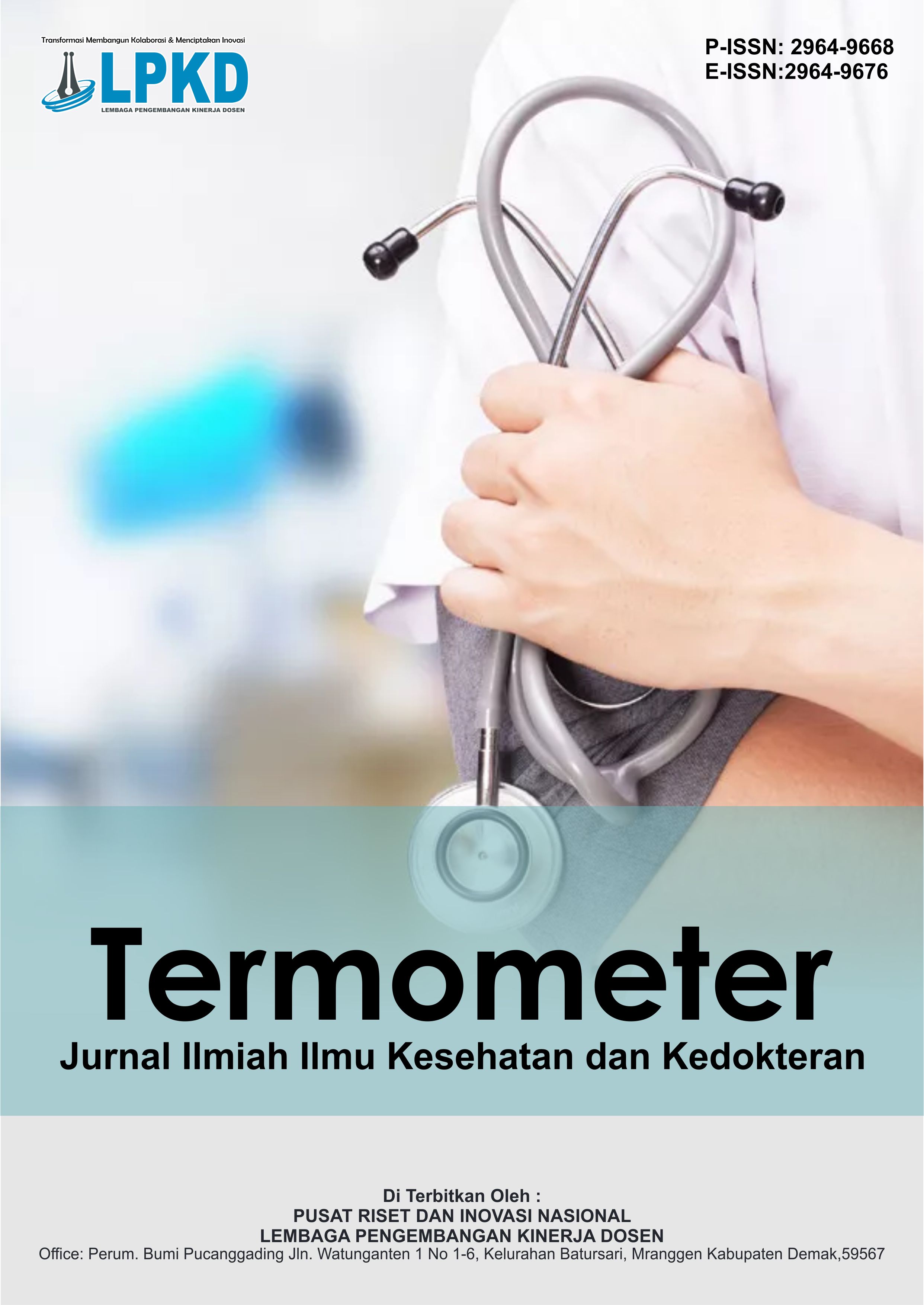Pengaruh Intervensi Emosi Positif pada Pengobatan Fibromyalgia
DOI:
https://doi.org/10.55606/termometer.v2i4.4367Keywords:
positive emotions, treatment, fibromyalgiaAbstract
This meta-analysis investigates the effectiveness of positive emotion-based interventions for patients with fibromyalgia. From a total of 1,247 identified articles, 32 studies (N=2,456 participants) met the inclusion criteria. The results indicate that positive emotion-based interventions significantly reduce pain intensity (g=-0.42, 95% CI [-0.56, -0.28], p<0.001), enhance quality of life (g=0.38, 95% CI [0.25, 0.51], p<0.001), and alleviate depressive symptoms (g=-0.35, 95% CI [-0.48, -0.22], p<0.001). Furthermore, moderator analysis reveals that the duration of the intervention significantly moderates its effects on pain intensity (β=-0.03, p=0.02) and quality of life (β=0.04, p=0.01) in fibromyalgia patients. Among the interventions, mindfulness-based approaches appear most effective in reducing pain (g=-0.51), while cognitive-behavioural therapy shows the greatest efficacy in improving quality of life (g=0.45). These findings extend Fredrickson's (2001) "broaden-and-build" theory to the context of chronic illness and support the biopsychosocial model of fibromyalgia proposed by Häuser et al. (2010). The researchers argue that these results align with Zautra et al. (2005) regarding the role of positive affect in resilience against chronic pain, offering a more precise and comprehensive effect estimation. Unlike previous meta-analyses focused on specific interventions (e.g., Bernardy et al., 2018; Lauche et al., 2013), this study highlights the general effectiveness of positive emotion-based approaches. Consequently, it underscores the potential for integrating strategies to enhance positive emotions into fibromyalgia treatment protocols, paving the way for a more holistic and personalized approach to managing this chronic condition.
Downloads
References
Ablin, J., Fitzcharles, M. A., Buskila, D., Shir, Y., Sommer, C., & Häuser, W. (2013). Treatment of fibromyalgia syndrome: Recommendations of recent evidence‐based interdisciplinary guidelines with special emphasis on complementary and alternative therapies. Evidence‐Based Complementary and Alternative Medicine, 2013(1), 485272. https://doi.org/10.1155/2013/485272
Arnold, L. M., Crofford, L. J., Mease, P. J., Burgess, S. M., Palmer, S. C., Abetz, L., & Martin, S. A. (2008). Patient perspectives on the impact of fibromyalgia. Patient Education and Counseling, 73(1), 114-120. https://doi.org/10.1016/j.pec.2008.06.005
Bartley, E. J., Robinson, M. E., & Staud, R. (2018). Pain and fatigue variability patterns distinguish subgroups of fibromyalgia patients. The Journal of Pain, 19(4), 372-381. https://doi.org/10.1016/j.jpain.2017.12.268
Bernardy, K., Klose, P., Welsch, P., & Häuser, W. (2018). Efficacy, acceptability and safety of cognitive behavioural therapies in fibromyalgia syndrome–A systematic review and meta‐analysis of randomized controlled trials. European Journal of Pain, 22(2), 242-260. https://doi.org/10.1002/ejp.1123
Berridge, K. C., & Kringelbach, M. L. (2015). Pleasure systems in the brain. Neuron, 86(3), 646-664. https://doi.org/10.1016/j.neuron.2015.02.018
Bushnell, M. C., Čeko, M., & Low, L. A. (2013). Cognitive and emotional control of pain and its disruption in chronic pain. Nature Reviews Neuroscience, 14(7), 502-511. https://doi.org/10.1038/nrn3516
Clauw, D. J. (2014). Fibromyalgia: A clinical review. Jama, 311(15), 1547-1555. https://doi.org/10.1001/jama.2014.3266
Davidson, R. J., & McEwen, B. S. (2012). Social influences on neuroplasticity: Stress and interventions to promote well-being. Nature Neuroscience, 15(5), 689-695. https://doi.org/10.1038/nn.3093
Davis, M. C., Zautra, A. J., & Reich, J. W. (2001). Vulnerability to stress among women in chronic pain from fibromyalgia and osteoarthritis. Annals of Behavioral Medicine, 23(3), 215-226. https://doi.org/10.1207/S15324796ABM2303_8
Davis, M. C., Zautra, A. J., Wolf, L. D., Tennen, H., & Yeung, E. W. (2015). Mindfulness and cognitive–behavioral interventions for chronic pain: Differential effects on daily pain reactivity and stress reactivity. Journal of Consulting and Clinical Psychology, 83(1), 24-35. https://doi.org/10.1037/a0038200
Dimidjian, S., Barrera Jr, M., Martell, C., Muñoz, R. F., & Lewinsohn, P. M. (2011). The origins and current status of behavioral activation treatments for depression. Annual Review of Clinical Psychology, 7(1), 1-38. https://doi.org/10.1146/annurev-clinpsy-032210-104535
Fava, G. A., & Ruini, C. (2003). Development and characteristics of a well-being enhancing psychotherapeutic strategy: Well-being therapy. Journal of Behavior Therapy and Experimental Psychiatry, 34(1), 45-63. https://doi.org/10.1016/S0005-7916(03)00019-3
Finan, P. H., & Garland, E. L. (2015). The role of positive affect in pain and its treatment. The Clinical Journal of Pain, 31(2), 177-187. https://doi.org/10.1097/AJP.0000000000000112
Finan, P. H., Zautra, A. J., & Davis, M. C. (2009). Daily affect relations in fibromyalgia patients reveal positive affective disturbance. Psychosomatic Medicine, 71(4), 474-482. https://doi.org/10.1097/PSY.0b013e31819e0e45
Fredrickson, B. L. (2001). The role of positive emotions in positive psychology: The broaden-and-build theory of positive emotions. American Psychologist, 56(3), 218-226. https://doi.org/10.1037/0003-066X.56.3.218
Garland, E. L., Froeliger, B., & Howard, M. O. (2015). Neurophysiological evidence for remediation of reward processing deficits in chronic pain and opioid misuse following treatment with mindfulness-oriented recovery enhancement: Exploratory ERP findings from a pilot RCT. Journal of Behavioral Medicine, 38(2), 327-336. https://doi.org/10.1007/s10865-014-9607-y
Geenen, R., & Bijlsma, J. W. (2010). Deviations in the endocrine system and brain of patients with fibromyalgia: Cause or consequence of pain and associated features? Annals of the New York Academy of Sciences, 1193(1), 98-110. https://doi.org/10.1111/j.1749-6632.2009.05369.x
Gracely, R. H., Petzke, F., Wolf, J. M., & Clauw, D. J. (2002). Functional magnetic resonance imaging evidence of augmented pain processing in fibromyalgia. Arthritis & Rheumatism, 46(5), 1333-1343. https://doi.org/10.1002/art.10225
Häuser, W., Thieme, K., & Turk, D. C. (2010). Guidelines on the management of fibromyalgia syndrome–A systematic review. European Journal of Pain, 14(1), 5-10. https://doi.org/10.1016/j.ejpain.2009.01.006
Häuser, W., Wolfe, F., Tölle, T., Üçeyler, N., & Sommer, C. (2012). The role of antidepressants in the management of fibromyalgia syndrome: A systematic review and meta-analysis. CNS Drugs, 26(4), 297-307. https://doi.org/10.2165/11598970-000000000-00000
Hutcherson, C. A., Seppala, E. M., & Gross, J. J. (2008). Loving-kindness meditation increases social connectedness. Emotion, 8(5), 720-724. https://doi.org/10.1037/a0013237
Jensen, K. B., Loitoile, R., Kosek, E., Petzke, F., Carville, S., Fransson, P., ... & Kong, J. (2012). Patients with fibromyalgia display less functional connectivity in the brain's pain inhibitory network. Molecular Pain, 8(1), 1-15. https://doi.org/10.1186/1744-8069-8-32
Kashikar-Zuck, S., Flowers, S. R., Claar, R. L., Guite, J. W., Logan, D. E., Lynch-Jordan, A. M., ... & Wilson, A. C. (2011). Clinical utility and validity of the Functional Disability Inventory among a multicenter sample of youth with chronic pain. Pain, 152(7), 1600-1607. https://doi.org/10.1016/j.pain.2011.02.050
Lauche, R., Cramer, H., Dobos, G., Langhorst, J., & Schmidt, S. (2013). A systematic review and meta-analysis of mindfulness-based stress reduction for the fibromyalgia syndrome. Journal of Psychosomatic Research, 75(6), 500-510. https://doi.org/10.1016/j.jpsychores.2013.10.010
López-Solà, M., Woo, C. W., Pujol, J., Deus, J., Harrison, B. J., Monfort, J., & Wager, T. D. (2017). Towards a neurophysiological signature for fibromyalgia. Pain, 158(1), 34-47. https://doi.org/10.1097/j.pain.0000000000000731
Melzack, R., & Wall, P. D. (1967). Pain mechanisms: A new theory. Survey of Anesthesiology, 11(2), 89-90. https://doi.org/10.1097/00132586-196704000-00022
Neff, K. D., & Germer, C. K. (2013). A pilot study and randomized controlled trial of the Mindful Self‐Compassion program. Journal of Clinical Psychology, 69(1), 28-44. https://doi.org/10.1002/jclp.21923
Okifuji, A., & Turk, D. C. (2006). Behavioral and cognitive-behavioral approaches to chronic pain: Disease management or symptom control? In D. C. Turk & R. J. Gatchel (Eds.), Psychological approaches to pain management: A practitioner’s handbook (2nd ed., pp. 333–358). Guilford Press.
Perrot, S., Winkelmann, A., Dukes, E., Xu, X., Schaefer, C., Ryan, K., ... & Zlateva, G. (2012). Characteristics of patients with fibromyalgia in real life and concordance with the ACR 1990 and 2010 criteria: Results from a cross‐sectional survey. Arthritis Care & Research, 64(3), 497-503. https://doi.org/10.1002/acr.21549
Schmidt-Wilcke, T., & Clauw, D. J. (2011). Fibromyalgia: From pathophysiology to therapy. Nature Reviews Rheumatology, 7(9), 518-527. https://doi.org/10.1038/nrrheum.2011.98
Schmidt-Wilcke, T., Luerding, R., Weigand, T., Leinisch, E., Stratz, T., Winkelmann, A., ... & Gänssbauer, S. (2007). Gray matter decrease in patients with chronic tension type headache. Neurology, 69(16), 1618-1624. https://doi.org/10.1212/01.wnl.0000277637.90458.c6
Serrat, M., Almirall, M., Musté, M., Sanabria‐Munoz, A., Feliu‐Soler, A., Méndez‐Ureña, R., ... & Luciano, J. V. (2021). The efficacy of a physical exercise programme supervised by specialists compared with usual care in patients with fibromyalgia: A randomized controlled trial. Rheumatology International, 41(8), 1393-1402. https://doi.org/10.1007/s00296-021-04872-2
Snyder, C. R., & Lopez, S. J. (2007). Positive psychology: The scientific and practical explorations of human strengths. Sage Publications.
Staud, R. (2011). Abnormal endogenous pain modulation is a shared characteristic of many chronic pain conditions. Expert Review of Neurotherapeutics, 11(11), 1449-1470. https://doi.org/10.1586/ern.11.121
Thieme, K., Flor, H., & Turk, D. C. (2015). Psychological pain treatment in fibromyalgia syndrome: Efficacy of operant behavioural and cognitive behavioural treatments. Arthritis Research & Therapy, 17(1), 1-7. https://doi.org/10.1186/s13075-015-0674-1
Tracey, I., & Mantyh, P. W. (2007). The cerebral signature for pain perception and its modulation. Neuron, 55(3), 377-391. https://doi.org/10.1016/j.neuron.2007.07.012
Downloads
Published
How to Cite
Issue
Section
License
Copyright (c) 2024 Termometer: Jurnal Ilmiah Ilmu Kesehatan dan Kedokteran

This work is licensed under a Creative Commons Attribution-ShareAlike 4.0 International License.










